
Zambia, the land of the legendary African walking safari, the thundering smoke of Victoria Falls, and a vibrant tapestry of cultures, offers an adventure that feels both timeless and thrillingly immediate. This is a nation where wilderness is still truly wild, and the warmth of the people is as vast as the stunning sunsets.

Planning a trip to such an authentic destination might seem daunting, but it's now easier than ever, especially with Zambia's streamlined e-Visa system.
This guide will walk you through the must-see wonders of Zambia and show you exactly how to secure your visa online, so you can focus on planning the adventure of a lifetime.
Why Is Zambia a Must-Visit African Destination?
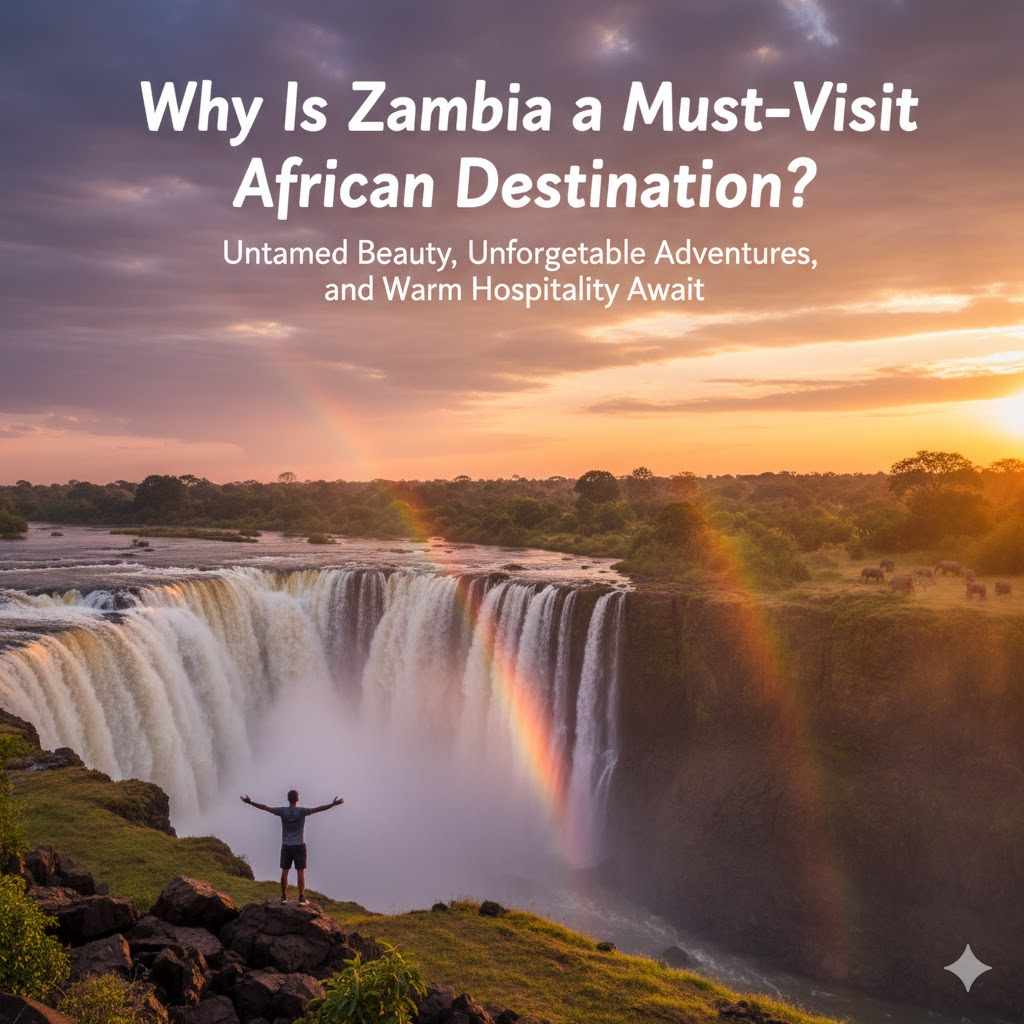
Often overshadowed by its neighbours, Zambia Hidden Gems for safari purists and adventure seekers. It boasts 20 national parks and some of the most pristine, unfenced wilderness on the continent. Here, you can experience game viewing from a canoe on the Lower Zambezi, track lions on foot in South Luangwa, or feel the raw power of one of the Seven Natural Wonders of the World. It's an experience that goes beyond the 4x4, connecting you directly to the pulse of the African bush.
Your First Step: How to Get a Zambia e-Visa
Forget embassy appointments and complex paperwork. Zambia’s e-Visa system makes the entry process incredibly straightforward.

Who needs a visa? Most nationalities, including citizens from the USA, UK, Canada, Australia, and most of the EU, require a visa to enter Zambia. The Zambia e-Visa is the easiest way to get it.
Step-by-Step Guide to the Zambia e-Visa Application:
Fill Out the Application: You'll need to enter your personal details, passport information, and the purpose of your visit (tourism).
Upload Your Documents: You will typically need scanned copies of:
Your passport's bio-data page (valid for at least 6 months).
A recent passport-sized photo.
A cover letter addressed to the Director-General of Immigration, briefly stating your travel dates and purpose.
Proof of accommodation (e.g., hotel or safari lodge booking confirmations).
A copy of your return flight itinerary.
Pay the Fee: The system will prompt you to pay the visa fee online.
Receive Your Approval: Processing time is usually 3-5 working days. Once approved, you will receive a Visa Approval Letter by email. Print this letter and present it to the immigration officer upon arrival in Zambia, who will then stamp the visa into your passport.
Pro-Tip: The KAZA UNIVISA If you plan to visit both Zambia and Zimbabwe (e.g., to see the falls from both sides), look into the Zambia Kaza Univisa. For $50 USD, it allows multiple entries into both countries within 30 days and even covers day trips to Botswana. You can apply for this via the same e-Visa portal.
It's that simple. Now, let's get to the exciting part: where you'll be using it.
The Top 10 Tourist Attractions in Zambia
From world wonders to remote wilderness, these are the sights you can't miss.
1. Victoria Falls (Mosi-oa-Tunya)
No list is complete without it. Known locally as "Mosi-oa-Tunya" or "The Smoke That Thunders," Victoria Falls is a sight, sound, and feeling you will never forget. This colossal curtain of water, over a mile wide, plunges 108 meters into the Batoka Gorge.

Getting There: The falls are the main feature of Livingstone town. Most hotels are a 5-10 minute taxi ride away, and some are within walking distance.
Genuine Visitor Problem: The water level completely changes the experience. Many tourists are disappointed to find they've come at the "wrong" time.
High-Water (Feb-May): The falls are an overwhelmingly powerful wall of spray. The problem? The sheer volume of mist can completely hide the rock face.
Low-Water (Aug-Jan): The falls are less powerful, and the Zambian side can become a small trickle. However, this is the only time you can see the rock formations clearly and access Devil's Pool.
Preparation: Bring a high-quality raincoat and a waterproof bag for your phone. The spray (especially in high-water) will soak you to the skin. Wear shoes with good grip, as the paths are slippery.
2. Devil's Pool
This is the ultimate thrill: a natural rock pool right on the precipice of the falls. You can swim to the edge and peer directly into the 108-meter abyss, with a rock lip stopping you from going over.

Getting There: Accessible only via a guided boat tour to Livingstone Island.
Genuine Visitor Problem: It is only open during the low-water season (roughly mid-August to late December). Tourists who book trips in March or April are devastated to find it's closed and far too dangerous to visit.
Preparation: You must book this tour months in advance, as it sells out. It's expensive (often over $150), but it's a once-in-a-lifetime experience. Listen carefully to your guides.
3. South Luangwa National Park
This is the birthplace of the walking safari and arguably one of the best safari destinations in Africa. It's world-renowned for its incredible density of leopards, lions, elephants, and hippos.

Getting There: This park is remote. The best way is to take a 1-hour internal flight from Lusaka to Mfuwe (MFU) airport. Driving from Lusaka is a long, 8-10 hour journey.
Genuine Visitor Problem: Tsetse flies. In some areas of the park, these biting flies can be a major nuisance. They are attracted to dark colors.
Preparation: Pack neutral-colored clothing (khaki, beige, green). Avoid blue and black clothing, as this will make you a target for tsetse flies. Pack light and in a soft-sided bag (duffel bag) as the small bush planes have strict weight limits (15-20kg) and will refuse hard-shell suitcases.
4. Lower Zambezi National Park
Where the safari meets the water. This stunning park, set on the banks of the mighty Zambezi River, offers a unique blend of land and water activities. Go on a classic game drive in the morning and spend the afternoon canoeing silently past herds of elephants drinking at the river's edge.
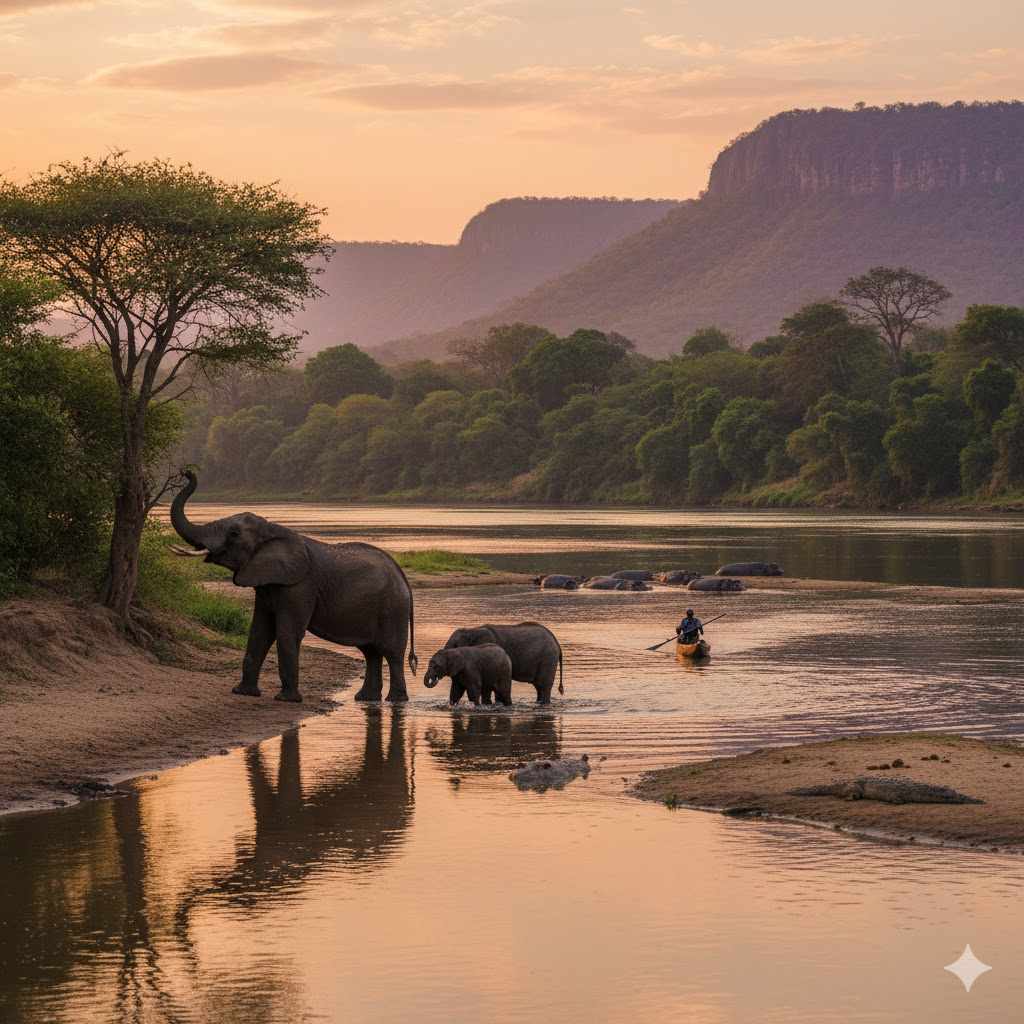
Getting There: You can take a 30-minute bush flight from Lusaka to one of the park's airstrips (e.g., Jeki). A road transfer is possible but takes 4+ hours over rough terrain.
Genuine Visitor Problem: The park's safari lodges are generally seasonal and close down during the heavy wet season (approx. November to April).
Preparation: Bring sunscreen and a wide-brimmed hat for the water. If you go canoeing, you will be exposed to the sun. Trust your guide—you will be canoeing very close to hippos and crocodiles, but the guides are experts at reading the water and animal behavior.
5. Kafue National Park
Zambia's largest and oldest national park is a vast, diverse wilderness. Its remote northern Busanga Plains are a highlight—a sprawling seasonal wetland that attracts massive herds of lechwe and puku, as well as the famous lions and cheetahs that hunt them.
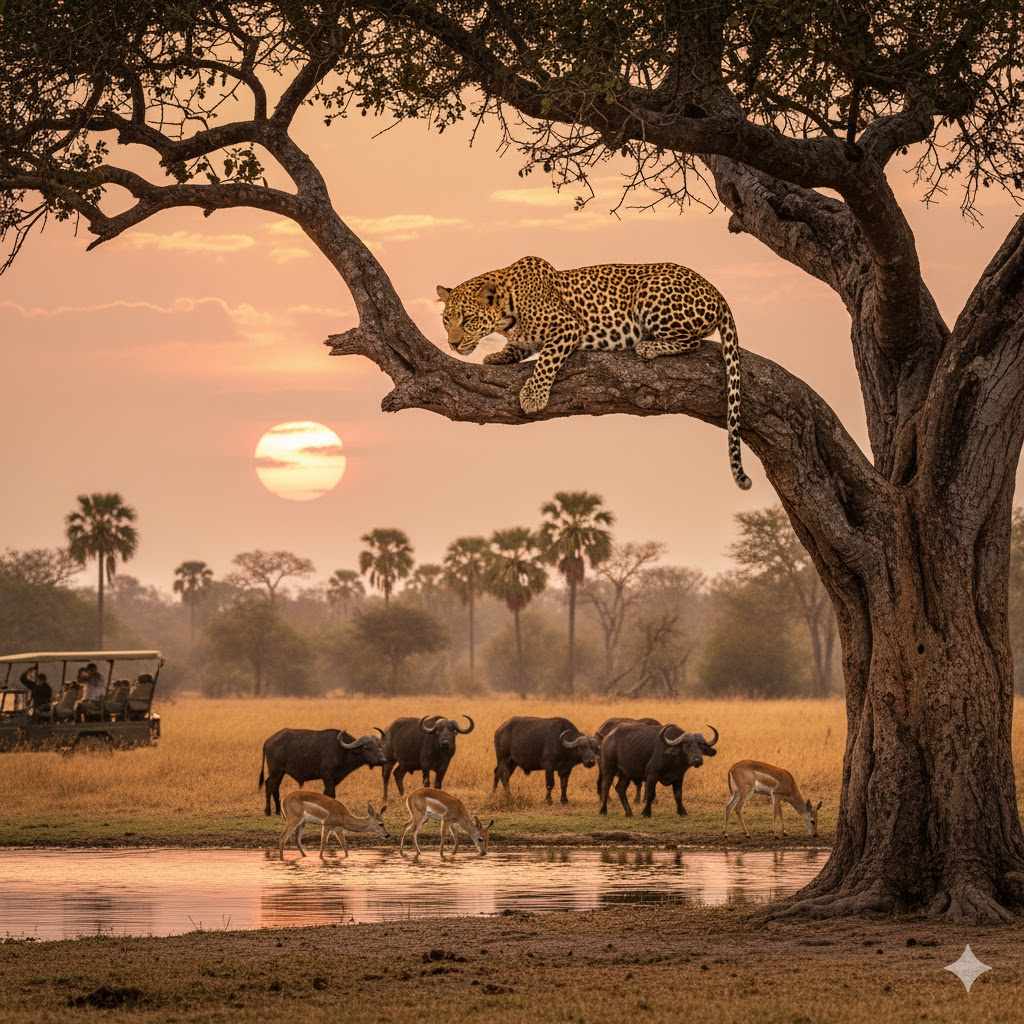
Getting There: Due to its size, "Kafue" is not one destination. The northern section (like Busanga Plains) is best reached by a bush flight from Lusaka. The southern section is a more manageable 3-4 hour drive from Livingstone.
Genuine Visitor Problem: Its sheer size means wildlife is more spread out than in South Luangwa. It's a "purist's" park where you work harder for sightings, but the reward is an incredibly wild and private experience.
Preparation: The Busanga Plains are only accessible in the dry season (July-October). If you drive, a 4x4 is non-negotiable.
6. Livingstone: The Adventure Capital
The charming colonial town of Livingstone is the gateway to Victoria Falls and Zambia's adventure hub. After you've seen the falls, you can go white-water rafting on the Zambezi (some of the wildest rapids in the world), bungee jump from the Victoria Falls Bridge, or take a microlight flight over the falls.

Getting There: Livingstone has an international airport (Harry Mwanga Nkumbula, LVI) with direct flights from Lusaka and other hubs like Johannesburg.
Genuine Visitor Problem: It can feel like a "tourist bubble," and the activities are priced for international tourists (in USD) and are expensive.
Preparation: For rafting, be prepared for a strenuous (but amazing) day and a very steep hike out of the gorge at the end.
7. The Mighty Zambezi River
The river is an attraction in itself. It defines the landscape and is the lifeblood for countless species. A sunset cruise on the upper Zambezi (above the falls) is a non-negotiable.

Getting There: Cruises leave from jetties all along the riverbank in Livingstone, and most lodges will book them for you.
Genuine Visitor Problem: Mosquitoes can be prevalent at dusk on the riverbank.
Preparation: Sipping a gin and tonic (a "G&T") while watching the sun dip below the horizon is a classic tradition. Bring insect repellent and a light jacket, as it can get cool on the water after sunset.
8. Lusaka: The Urban Heart
Do not pass through the capital. Lusaka is a colorful account of the new life in Zambia. Experience sensory overload in the busy Soweto Market (one of the largest in Zambia), see the rescued calves in the Lilayi Elephant Nursery and shop local crafts of high quality in the Kabwata Cultural Village.

Arrivals: Lusaka is the primary international airport of the country (LUN), which also serves as the center of most domestic flights to the safari.
True Visitor Issues: The traffic is widely known to be terrible and hectic. Do not think of making tight transfers across town. Thefts may become an issue in markets with a high density of people.
Arrangement: Make a registered taxi or ride-hailing application. Travelling to a market such as Soweto, keep an eye on your wallet and purse, avoid carrying your valuables, and hire someone to show you around.
9. Lake Kariba
Lake Kariba, the largest of the artificial lakes in the world, is known as the Zambian riviera. Its naked, gorgeous scenery of petrified trees growing out of the water is chillingly gorgeous. It is a leading houseboat holiday resort, fishing and water relaxation resort.

How to get there: Zambia The primary hub on the Zambian side is Siavonga, 3-4 hours south of Lusaka.
Authentic Visitors Issue: It is not a safari-style attraction as the parks are. It is an excursion that is concentrated on leisure, fishing, and boating.
Preparation: This is a great complement in case you have some more time to spend after your safari. The traditional method of enjoying the lake is to book a houseboat and enjoy the lake with a group.
10. Liuwa Plain National Park
Liuwa Plain is something different to the mature safari-goer. The second largest wildebeest migration in Africa (approx. Nov/Dec) happens in this remote and vast grass land in the far west. It is a land of unbelievably harsh and beautiful beauty and it has a lion pride and massive groups of hyenas that dwell in it.

Accessibility: This is one of the most isolated places in Africa. It involves domestic flights between Lusaka and it is very costly to reach.
Real Visitor Problem: It is hard to access, hard to visit and expensive, and has very little accommodation. It is only available during a couple of months a year.
Planning: It is a journey of a serious safari lover. It has to be arranged well beforehand with a professional tour company.
When Is the best time to visit Zambia?
The right season is one of the main keys to your trip.
Dry Season (May to October): It is the most opportune season to view the game. The climate is cool and the animals are found in the rivers and water holes which increase their visibility. It is also the best occasion to visit Devil's Pool and such parks as Busanga Plains.
Wet Season (November to April): It is the Emerald Season. The bush is also green and it is the most appropriate time to watch birds as the migratory birds come. Nevertheless, numerous safari camps are closed down and certain roads are impassable. The falls are at full blast (though the spray may be obscurant).
Is Zambia Safe for Tourists?
Zambia is considered to be one of the safest African countries to visit. The Zambians are also extremely friendly, welcoming and peaceful. Just like in any other travel, use common sense: lock up in the cities, never walk alone at night in the urban areas, and newcomers to the national parks must heed the safety briefing of their guides on their safari.
Last Minute Travel Advice when going on an adventure to Zambia
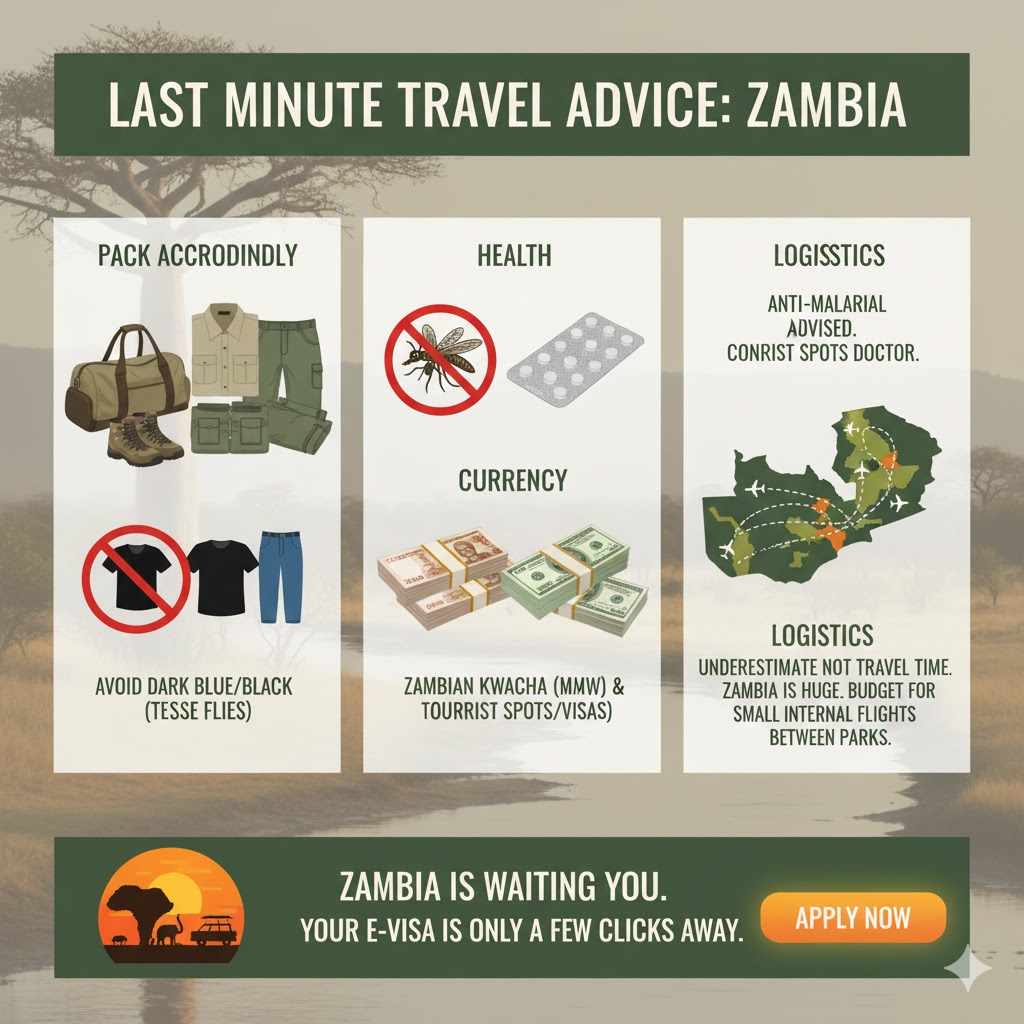
Pack Accordingly: Pack neutral-colored clothes (khaki, green, brown) to go on safaris. Dark blue/black should be avoided as this will attract tsetse flies. Light-weight and soft-sided duffel bags should also be packed in case of any internal flights to the bushes.
Health: Use anti-malarial medication which is advised by your doctor due to the fact that it is mostly suggested in the country.
Currency: The currency of the country is the Zambian Kwacha (ZMW), although the US dollars are fairly popular in tourist spots and when paying visas.
Logistics: Underestimate not the time spent traveling between parks. Zambia is a huge country. Small internal flights are the only best means of getting between the safari destinations and therefore must be budgeted.
Zambia is waiting for you. The way to a memorable African adventure has never been so obvious, as your e-Visa is only a few clicks away.
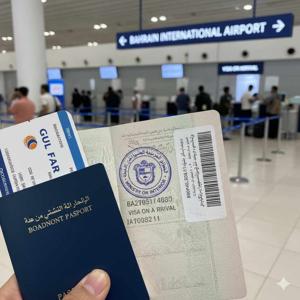


Write a comment ...